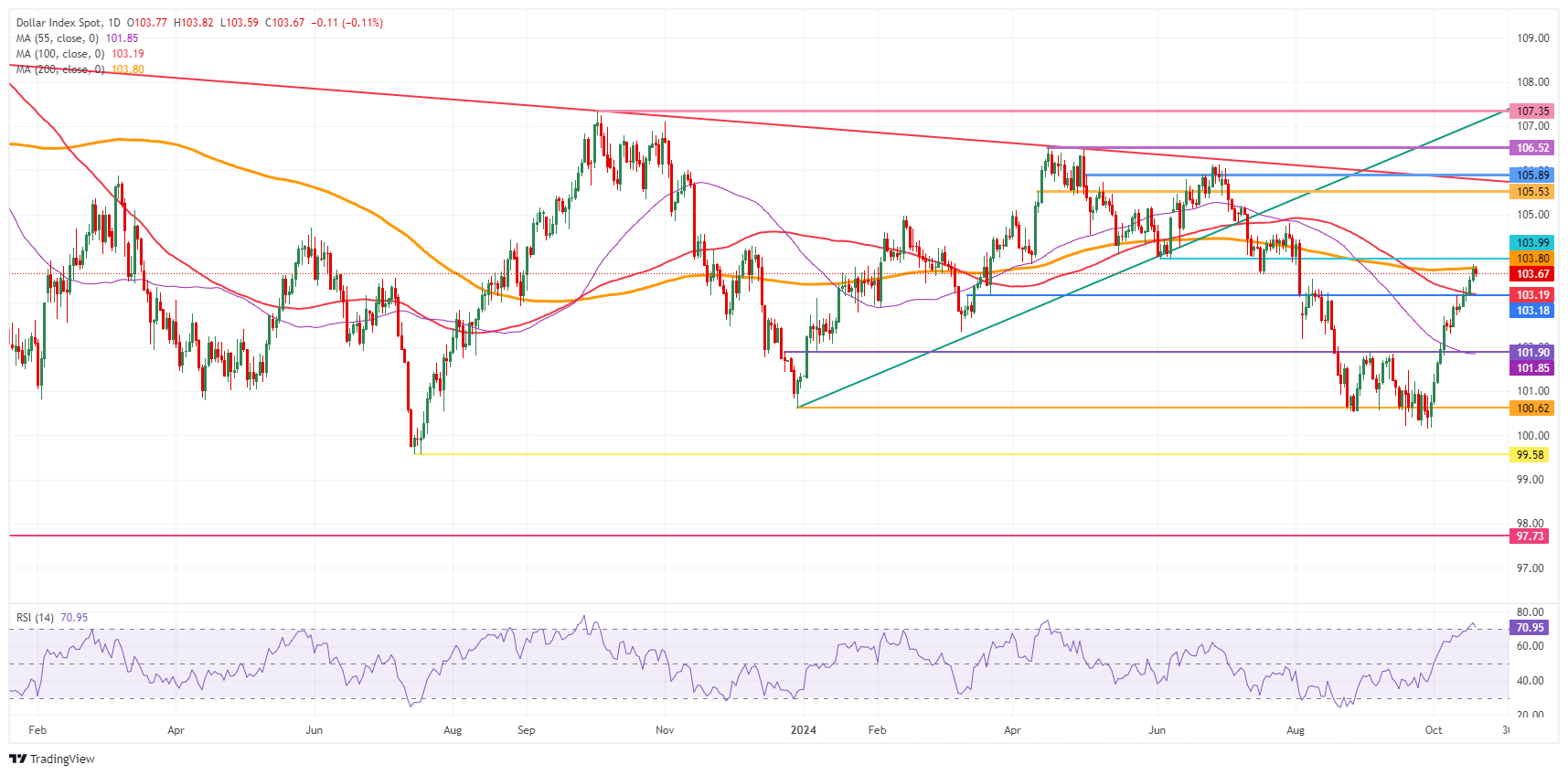- The US Dollar sees fade broaden on Friday after a steep ride higher.
- Traders see China stepping up measures with deposit rate cuts and more stimulus details.
- The US Dollar Index rally looks to be halting for now, ahead of 104.00.
The US Dollar (USD) eases on Friday in the US trading session, under some profit-taking after steep rallies against many major G20 currencies this week. The slight retracement comes on the back of Chinese economic data and more details on the stimulus package the Chinese government is rolling out. With Chinese deposit rates being cut this Friday and more details released on the Chinese stimulus package, it looks like China is propping up its economy further.
The US calendar is very light in terms of economic data. No real market-moving data points will be issued on Friday, with only Building Permits and Housing Starts on deck. Instead, look for the Federal Reserve (Fed), where no less than three members are set to speak.
Daily digest market movers: Here come the speakers
- At 12:30 GMT, the US Census Bureau will release housing data for September. Monthly Building Permits fell to 1.428 million, compared to 1.47 million in August, while Housing Starts fell to 1.354 million against 1.61 million prior.
- At 13:30 GMT, Federal Reserve Bank of Atlanta President Raphael Bostic delivers a presentation about economic education to high school students as part of the Mississippi Council on Economic Education Event.
- Around 14:00 GMT, Federal Reserve Bank of Minneapolis President Neel Kashkari moderates a policy panel at the 2024 Macroeconomic Policy Perspectives hosted by the Minneapolis Fed, the University of Chicago, and Stanford University.
- Near 16:10 GMT, Federal Reserve Governor Christopher Waller delivers a speech about decentralized finance at the Nineteenth Annual Vienna Macroeconomics Workshop in Vienna, Austria.
- At 16:30, Fed’s Bostic gives remarks and participates in a moderated conversation at the Mississippi Council on Economic Education's Forum on American Enterprise luncheon, United States.
- Asian equities saw Chinese indices outperform on the extra wave of stimulus measures issued. European equities are trying to grasp European Central Bank President Christine Lagarde’s speech from Thursday on the sluggish European economy. US futures are flat on the day and are yet to choose a direction.
- The CME Fed rate expectation for the meeting on November 7 shows a 90.2% probability of a 25 bps rate cut, while the remaining 9.8% is pricing in no rate cut. Chances for a 50 bps rate cut have been fully priced out.
- The US 10-year benchmark rate is trading at 4.11% after having flirted with a break below 4% on Wednesday.
US Dollar Index Technical Analysis: Fed vs Politics
The US Dollar Index (DXY) sees the rally train come to a halt, with some better-than-expected Chinese data and measures taken by the Chinese government to support domestic demand. Though this rally might face a small fade, a big reversal does not seem to be in the cards. With the interest rate gap between the US, the Eurozone and other coutnries widening again, the Greenback should at least remain supported towards the US elections in November.
A firm resistance ahead is 103.80, which aligns with the 200-day SMA. Above that, there is a small gap before hitting the pivotal level at 103.99 and the 104.00 big figure. Should Trump further lead in the polls, a rapid swing up to 105.00 and 105.53 could be on the cards.
On the downside, the 100-day SMA at 103.19 and the pivotal level at 103.18 are now acting as support and should prevent the DXY from falling lower. With the Relative Strength Index in overbought territory, a test on this level looks granted. Further down, the 55-day SMA at 101.85 and the pivotal level at 101.90 should avoid further downside moves.
US Dollar Index: Daily Chart
Central banks FAQs
Central Banks have a key mandate which is making sure that there is price stability in a country or region. Economies are constantly facing inflation or deflation when prices for certain goods and services are fluctuating. Constant rising prices for the same goods means inflation, constant lowered prices for the same goods means deflation. It is the task of the central bank to keep the demand in line by tweaking its policy rate. For the biggest central banks like the US Federal Reserve (Fed), the European Central Bank (ECB) or the Bank of England (BoE), the mandate is to keep inflation close to 2%.
A central bank has one important tool at its disposal to get inflation higher or lower, and that is by tweaking its benchmark policy rate, commonly known as interest rate. On pre-communicated moments, the central bank will issue a statement with its policy rate and provide additional reasoning on why it is either remaining or changing (cutting or hiking) it. Local banks will adjust their savings and lending rates accordingly, which in turn will make it either harder or easier for people to earn on their savings or for companies to take out loans and make investments in their businesses. When the central bank hikes interest rates substantially, this is called monetary tightening. When it is cutting its benchmark rate, it is called monetary easing.
A central bank is often politically independent. Members of the central bank policy board are passing through a series of panels and hearings before being appointed to a policy board seat. Each member in that board often has a certain conviction on how the central bank should control inflation and the subsequent monetary policy. Members that want a very loose monetary policy, with low rates and cheap lending, to boost the economy substantially while being content to see inflation slightly above 2%, are called ‘doves’. Members that rather want to see higher rates to reward savings and want to keep a lit on inflation at all time are called ‘hawks’ and will not rest until inflation is at or just below 2%.
Normally, there is a chairman or president who leads each meeting, needs to create a consensus between the hawks or doves and has his or her final say when it would come down to a vote split to avoid a 50-50 tie on whether the current policy should be adjusted. The chairman will deliver speeches which often can be followed live, where the current monetary stance and outlook is being communicated. A central bank will try to push forward its monetary policy without triggering violent swings in rates, equities, or its currency. All members of the central bank will channel their stance toward the markets in advance of a policy meeting event. A few days before a policy meeting takes place until the new policy has been communicated, members are forbidden to talk publicly. This is called the blackout period.
Information on these pages contains forward-looking statements that involve risks and uncertainties. Markets and instruments profiled on this page are for informational purposes only and should not in any way come across as a recommendation to buy or sell in these assets. You should do your own thorough research before making any investment decisions. FXStreet does not in any way guarantee that this information is free from mistakes, errors, or material misstatements. It also does not guarantee that this information is of a timely nature. Investing in Open Markets involves a great deal of risk, including the loss of all or a portion of your investment, as well as emotional distress. All risks, losses and costs associated with investing, including total loss of principal, are your responsibility. The views and opinions expressed in this article are those of the authors and do not necessarily reflect the official policy or position of FXStreet nor its advertisers. The author will not be held responsible for information that is found at the end of links posted on this page.
If not otherwise explicitly mentioned in the body of the article, at the time of writing, the author has no position in any stock mentioned in this article and no business relationship with any company mentioned. The author has not received compensation for writing this article, other than from FXStreet.
FXStreet and the author do not provide personalized recommendations. The author makes no representations as to the accuracy, completeness, or suitability of this information. FXStreet and the author will not be liable for any errors, omissions or any losses, injuries or damages arising from this information and its display or use. Errors and omissions excepted.
The author and FXStreet are not registered investment advisors and nothing in this article is intended to be investment advice.
Recommended content
Editors’ Picks

Gold gives away some gains, slips back to $2,980
Gold retraced from its earlier all-time highs above the key $3,000 mark on Friday, finding a footing around $2,980 per troy ounce. Profit-taking, rising US yields, and a shift to a risk-on environment seem to be putting the brakes on further gains for the metal.

EUR/USD remains firm and near the 1.0900 barrier
EUR/USD is finding its footing and trading comfortably in positive territory as the week wraps up, shaking off two consecutive daily pullbacks and setting its sights back on the pivotal 1.0900 mark—and beyond.

GBP/USD remains depressed, treads water in the low-1.2900s
GBP/USD is holding steady in consolidation territory after Friday’s opening bell on Wall Street, hovering in the low-1.2900 range. This resilience comes despite disappointing UK data and persistent selling pressure on the USD.

Crypto Today: BNB, OKB, BGB tokens rally as BTC, Shiba Inu and Chainlink lead market rebound
Cryptocurrencies sector rose by 0.13% in early European trading on Friday, adding $352 million in aggregate valuation. With BNB, OKB and BGB attracting demand amid intense market volatility, the exchange-based native tokens sector added $1.9 billion.

Week ahead – Central banks in focus amid trade war turmoil
Fed decides on policy amid recession fears. Yen traders lock gaze on BoJ for hike signals. SNB seen cutting interest rates by another 25bps. BoE to stand pat after February’s dovish cut.

The Best brokers to trade EUR/USD
SPONSORED Discover the top brokers for trading EUR/USD in 2025. Our list features brokers with competitive spreads, fast execution, and powerful platforms. Whether you're a beginner or an expert, find the right partner to navigate the dynamic Forex market.
